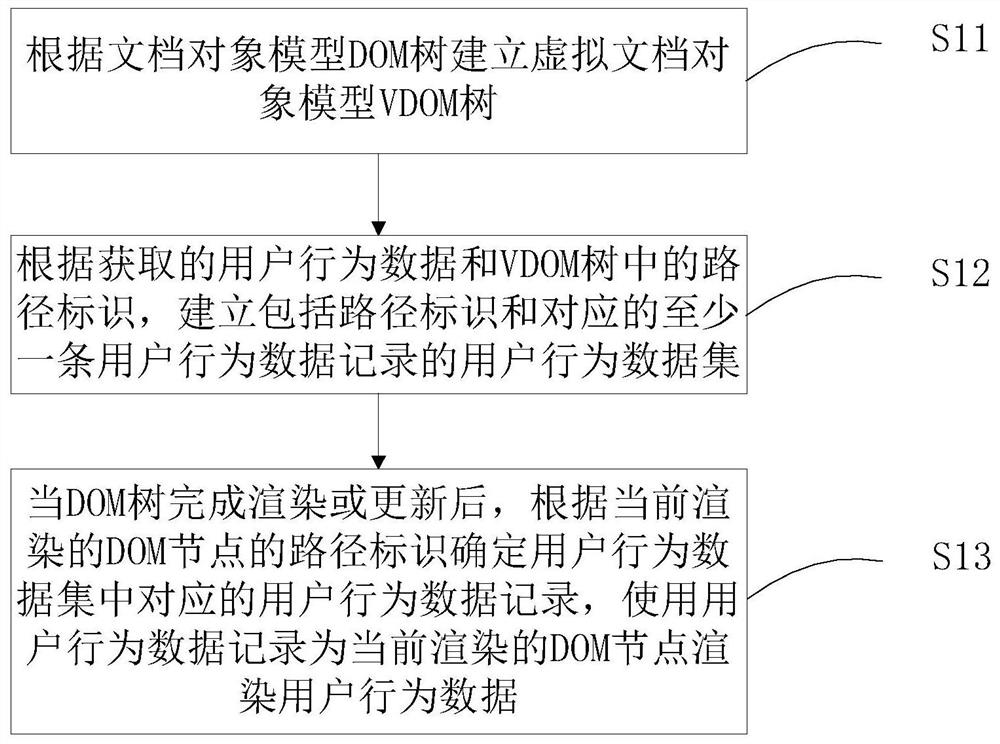User behavior data rendering method and device
A technology of data rendering and behavior, applied in the field of data rendering, which can solve the problems of rendering user behavior data, unable to render user behavior data, and unable to realize interactive rendering, etc., and achieve the effect of reducing the running burden
- Summary
- Abstract
- Description
- Claims
- Application Information
AI Technical Summary
Problems solved by technology
Method used
Image
Examples
Embodiment 1
[0064] Embodiment 1 of the present invention provides a user behavior data rendering method, the process of which is as follows figure 1 shown, including the following steps:
[0065] Step S11: Establish a virtual document object model VDOM tree according to the document object model DOM tree.
[0066] Among them, the DOM tree includes the information of the entire page, that is, the page effect presented by the browser and seen by the user. The DOM nodes included in the DOM tree are objects in the page, and the VDOM nodes in the VDOM tree are used to represent the objects in the page, and there is a one-to-one correspondence between the DOM nodes and the VDOM nodes. At the same time, the VDOM nodes in the VDOM tree are marked with the path identifiers of the corresponding DOM nodes in the DOM tree.
[0067] The objects of the above-mentioned pages may be controls displayed on the page, or background data not displayed. The user behavior data rendering in this application is...
Embodiment 2
[0096] Embodiment 2 of the present invention provides a specific implementation method for user behavior data rendering, the process of which is as follows Figure 5 shown, including the following steps:
[0097] Step S51: Establish a virtual document object model VDOM tree according to the document object model DOM tree.
[0098] Step S52: According to the obtained user behavior data and the path identifier in the VDOM tree, establish a user behavior data set including the path identifier and at least one corresponding user behavior data record.
[0099] The method for collecting specific user behavior data will be introduced in the third embodiment.
[0100] After the DOM tree is rendered or updated for the first time, follow-up steps S53 to S59 are performed.
[0101] Step S53: traverse the user behavior data set, and determine whether the DOM node corresponding to the path identifier of the currently traversed user behavior data record is rendered in the current page.
...
Embodiment 3
[0115] Embodiment 3 of the present invention provides a method for obtaining user behavior data by using buried points, including, when an object in a page is triggered by a specified user behavior, returning the path identifier of the DOM node corresponding to the object to the server, so that the server counts the path identifier corresponding to User behavior data records to generate user behavior data. refer to Figure 7 As shown, it specifically includes the following steps:
[0116] During the process of establishing the virtual document object model VDOM tree, step S71 and step S72 are executed.
[0117] Step S71: Determine whether the path identifier of the current VDOM node is marked.
[0118] If not, execute step S72.
[0119] Step S72: mark the path identifier for the current VDOM node.
[0120] The path information included in the path identifier may indicate the position (path) of the DOM node corresponding to the VDOM node in the DOM tree.
PUM
 Login to View More
Login to View More Abstract
Description
Claims
Application Information
 Login to View More
Login to View More - R&D
- Intellectual Property
- Life Sciences
- Materials
- Tech Scout
- Unparalleled Data Quality
- Higher Quality Content
- 60% Fewer Hallucinations
Browse by: Latest US Patents, China's latest patents, Technical Efficacy Thesaurus, Application Domain, Technology Topic, Popular Technical Reports.
© 2025 PatSnap. All rights reserved.Legal|Privacy policy|Modern Slavery Act Transparency Statement|Sitemap|About US| Contact US: help@patsnap.com



